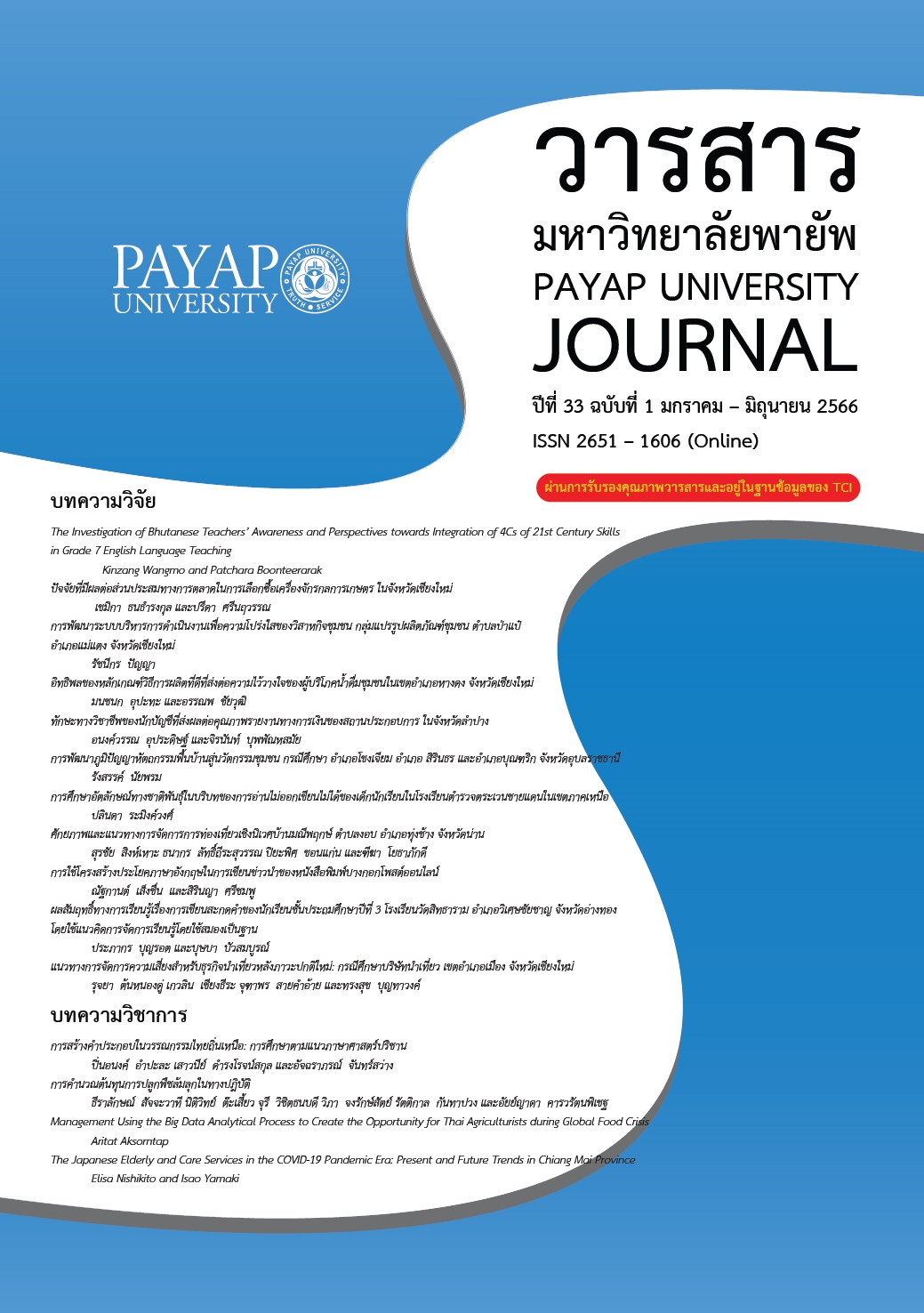การพัฒนาภูมิปัญญาหัตถกรรมพื้นบ้านสู่นวัตกรรมชุมชน กรณีศึกษา อำเภอโขงเจียม อำเภอสิรินธร และอำเภอบุณฑริก จังหวัดอุบลราชธานี
Main Article Content
บทคัดย่อ
การวิจัยครั้งนี้มีวัตถุประสงค์เพื่อศึกษาภูมิปัญญาหัตถกรรมพื้นบ้านสู่นวัตกรรมชุมชน อันจะนำไปสู่นวัตกรรมชุมชนเชิงสร้างสรรค์ และเพื่อพัฒนาต้นแบบนวัตกรรมชุมชนหัตถกรรมพื้นบ้านตามแนวชายแดนจังหวัดอุบลราชธานี โดยใช้แนวคิดเศรษฐกิจสร้างสรรค์ ได้แก่ อำเภอโขงเจียม อำเภอสิรินธร และอำเภอบุณฑริก การวิจัยนี้เป็นการวิจัยเชิงคุณภาพ ซึ่งผู้วิจัยเลือกใช้เครื่องมือ ในการวิจัย ได้แก่ แบบสัมภาษณ์เชิงลึก แบบบันทึกการสังเกตแบบมีส่วนร่วมและไม่มีส่วนร่วม เพื่อเก็บข้อมูลจากกลุ่มเป้าหมาย คือ ปราชญ์ชาวบ้าน ผู้นำชุมชน สมาชิกกลุ่มหัตกรรม จำนวน 20 คน ผลการศึกษาพบว่า 1) ด้านความหลากหลายของภูมิปัญญาหัตถกรรมพื้นบ้านในชุมชนชายแดน จังหวัดอุบลราชธานี พบว่า หัตถกรรมที่เป็นเครื่องใช้ในครัวเรือนและหัตถกรรมที่เป็นเครื่องมือ ดักจับสัตว์ 10 ชนิด ได้แก่ ก่องข้าว กระติบข้าว หวด กระด้ง ข้อง ตะกร้า จองตักปลาแดก ตุ้มกบ ฝาชี และไม้กวาดทางมะพร้าว 2) ด้านการพัฒนาต้นแบบนวัตกรรมชุมชนหัตถกรรมพื้นบ้าน ตามแนวชายแดน จังหวัดอุบลราชธานี พบว่ามี 3 ขั้นตอน ได้แก่ (1) ขั้นการจัดเวทีเพื่อระดม ความคิดเห็นของชุมชน (2) ขั้นการพัฒนาต้นแบบนวัตกรรมหัตถกรรมพื้นบ้าน (3) ขั้นคืนความรู้สู่ชุมชน ซึ่งส่งผลให้ได้ผลิตภัณฑ์ต้นแบบ 5 แบบ คือ กระถางต้นไม้จากตะกร้า กระถางต้นไม้จากหวด กระเป๋าจากหวดแบบที่ 1 กระเป๋าจากหวดแบบที่ 2 และกระเป๋าจากกระติบข้าว ทั้งนี้ ได้มีการนำเอานวัตกรรม ภายใต้แนวคิดเศรษฐกิจสร้างสรรค์มาปรับใช้เพื่อพัฒนาต่อยอดภูมิปัญญาหัตถกรรมพื้นบ้านของชุมชนชายแดนอันจะนำไปสู่การเสริมสร้างเศรษฐกิจชุมชนจากฐานราก ตลอดจนการขับเคลื่อน ระบบเศรษฐกิจกระแสใหม่ที่จะส่งผลให้ชุมชนเกิดความเข้มแข็งและยั่งยืน
Article Details
เอกสารอ้างอิง
จักรกริช สังขมณี. (2561). Limology ชายแดนศึกษา กับ เขต-ขันธ์วิทยาของพื้นที่ใน/ระหว่าง. ศยาม.
ญาณิศา เผื่อนเพาะ และประสพชัย พสุนนท์. (2564). นวัตกรรมชุมชนเชื่อมโยงเศรษฐกิจชุมชนสู่ความยั่งยืน. วารสารวิทยาการจัดการ มหาวิทยาลัยราชภัฏนครปฐม, 8(2), 32-44.
ภริตพร แก้วแกมเสือ. (2562). การอนุรักษ์ สืบสานและพัฒนางานศิลปหัตถกรรมพื้นบ้านเครื่องจักสาน โดยแนวคิดทางการออกแบบผลิตภัณฑ์. สารอาศมวัฒนธรรมวลัยลักษณ์, 19(2), 68-96.
มานิตย์ โศกค้อ. (2562). การมีส่วนร่วมของชุมชนในการพัฒนาภูมิปัญญาเครื่องจักสานพื้นบ้านสู่นวัตกรรมชุมชนตามแนวทางเศรษฐกิจสร้างสรรค์ กรณีศึกษา ชุมชนชาวบรูบ้านท่าล้ง ตำบลห้วยไผ่ อำเภอโขงเจียม จังหวัดอุบลราชธานี. สำนักงานสนับสนุนการวิจัยแห่งชาติ.
ยศ สันตสมบัติ. (2559). The Border คน พรมแดน รัฐชาติ. ภาพพิมพ์.
วิบูลย์ ลี้สุวรรณ. (2553). ศิลปหัตถกรรมพื้นบ้าน: เอกลักษณ์เฉพาะถิ่น. วารสารมหาวิทยาลัยศิลปากร, 30(1), 163-182.
ศมลพรรณ ภู่เล็ก. (2564). การศึกษาอัตลักษณ์ภูมิปัญญางานจักสานและงานทอจังหวัดนครสวรรค์ เพื่อการออกแบบผลิตภัณฑ์กระเป๋าไม้ไผ่. วารสารวิชาการ คณะมนุษยศาสตร์และสังคมศาสตร์ มหาวิทยาลัยนครสวรรค์, 8(1), 40-60.
สาคร ฉลวยศรี และรังสรรค์ นัยพรม. (2564). การพัฒนาภูมิปัญญาผลิตภัณฑ์จากไม้สู่นวัตกรรมชุมชน กรณีศึกษา อำเภอสิรินธร และอำเภอพิบูลมังสาหาร. สำนักงานคณะกรรมการส่งเสริม วิทยาศาสตร์ วิจัยและนวัตกรรม.
สุนทร วรหาร และมานิตย์ โศกค้อ. (2557). การมีส่วนร่วมของชุมชนในการสืบทอดวรรณกรรมพื้นบ้านของชาวบรู บ้านเวินบึก อำเภอโขงเจียม จังหวัดอุบลราชธานี. สำนักงานคณะกรรมการอุดมศึกษา.
สำนักงานสภาพัฒนาการเศรษฐกิจและสังคมแห่งชาติ. (2563). รายงานสรุปผลการดำเนินการตามยุทธศาสตร์ชาติ ประจำปี 2562. ผู้แต่ง.
เสาวรัจ รัตนคำฟู, กรรณิการ์ ธรรมพานิชวงค์, บุญวรา สุมะโน และสลิลธร ทองมีนสุข. (2564). การปรับโครงสร้างแรงงานสร้างสรรค์ในอุตสาหกรรมสร้างสรรค์ของไทยในยุคหลังโควิด-19. มูลนิธิสถาบันวิจัยเพื่อการพัฒนาประเทศไทย.


